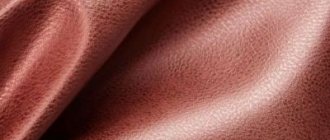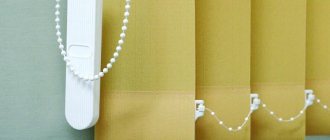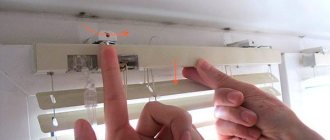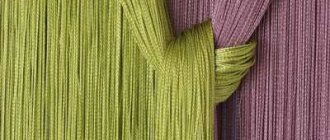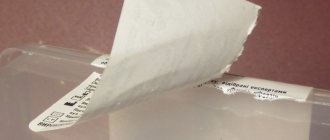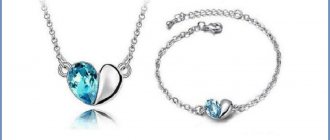Roman blinds are attached to a curtain rod, which makes caring for them more complicated. The easiest way to maintain the attractiveness of the material is dry cleaning, but periodically you need to use the wet method. To do this, you should learn how to wash Roman blinds, since impregnation does not provide complete protection from dust.
Can Roman blinds be washed?
Caring for the canvas is a mandatory measure, since a large amount of dust penetrates through the window. Curtains hold it in, so they quickly get dirty.
To remove dust, different methods are used: dry, wet cleaning. The first option is used more often, because it does not violate the structure of the material. However, wet cleaning of Roman blinds is also allowed, only in this case it is important to take into account the properties of the fabric.
Types of materials that can be washed: synthetic, natural and mixed fabrics. It is not recommended to expose curtains made of bamboo, paper, or jute to moisture: they will quickly fail. In addition, there are varieties of curtains, the fabric of which is treated with special compounds to increase resistance to stains. The impregnation will quickly lose its properties if the care rules are not followed.
Selecting a cleaning option
Caring for Roman blinds involves periodically cleaning the fabric from dust and other contaminants. The choice of technology depends on the material from which the curtain fabric is made. Manufacturers use:
- textiles made of cotton or synthetic thread;
- natural and non-standard materials (jute, bamboo, paper, etc.).
Textile fabrics can be washed by removing them from the curtain rods. Roman blinds made from natural materials can only be dry cleaned, and there is no need to disassemble the structure.
It is important to remember that it is not recommended to wash fabric sheets frequently and violate the gentle washing technology, since this leads to the loss of the dust-repellent layer on the surface of the material - the curtains will become dirty much faster. In addition, frequent washing worsens the appearance of the product and accelerates its wear.
In order to wash textile Roman blinds as little as possible, they should be regularly cleaned with a vacuum cleaner and ventilated by slightly opening the window sash.
Compliance with washing and cleaning technology will not save the fabric from deformation and fading if it was originally made of low-quality material. In such cases, the service life of the product can be extended if you protect the curtains from moisture and high temperature.
How to remove before washing
Consider the method of fastening the canvas:
- the base hidden behind the front panel of the cornice (part of the structure is dismantled, the screws are unscrewed);
- bracket with spring;
- Velcro on the base of the cornice.
The latter option is used more often due to its simplicity of design. The canvas is easily separated from the base, but strips remain on it, giving rigidity and the desired shape. They also need to be removed. For this purpose, the canvas is provided with peculiar pockets - places hidden by an additional layer of material where the strips are contained. In most cases, they are closed only on one side, less often - on both.
When the strip on the sides is sewn up, you can carefully rip the product in these areas, and after washing, sew these areas up again, but it is not necessary.
Preparatory stage
First of all, determine what material is used in the manufacture of Roman blinds. The choice of cleaning or washing method depends on this.
- Remove the canvas from the cornice. It is attached to it with Velcro.
- Unfasten the laces that are passed through the entire fabric from the rings on the weights located at the end of the product.
- After removing from the window opening, remove the slats, or they are also called guide rods. It is quite easy to pull them out of the fabric, since on one side the edge of the product is left unstitched. If it turns out to be sewn up, carefully rip it open and after washing and inserting the slats, sew it back up.
After removing the components, Roman blinds turn into an ordinary piece of material and are convenient for washing.
Features of washing depending on the material
Exposure of the fabric to moisture can cause the product to lose its shape. Therefore, it is important to first study the manufacturer's recommendations for caring for the product. If the fabric is impregnated with a special dust-repellent composition, the frequency of washing is reduced.
Natural fabric
This group includes materials with special properties: bamboo, thick paper, eucalyptus, burlap (jute). Paper products are destroyed when in contact with water. Products made from other materials are better able to withstand exposure to liquids, but in this case the risk of changing the shape of the fabric increases. For this reason, it is better to use the dry cleaning method.
Possible dust removal options:
- processing in the fresh air (for this you need to remove the canvas);
- removing dust from curtains with a vacuum cleaner;
You can also wipe off dirt from the surface with a dry cloth, but there is a risk of streaks.
Linen
The maximum water temperature during washing is +50°C.
Recommendations for caring for this type of product:
- use manual and automatic washing methods (in the second case, the delicate mode is set);
- squeeze out the material with minimal effort;
- dry linen curtains in a vertical position;
- iron the product when the fabric is still slightly sensitive (this will avoid the appearance of kinks in the material);
- use oxygen-based products if you need to restore the whiteness of the fabric.
Silk
This material is more demanding to care for, does not tolerate exposure to sunlight, and therefore lasts less.
To increase its service life, it is recommended to adhere to the following recommendations:
- use hand wash method;
- do not wring out the product;
- For washing, use only detergents with color-preserving properties;
- iron silk through a layer of natural fabric (cotton) at a minimum temperature so that shiny marks from the iron do not remain.
Tulle
Machine washing mode parameters:
- temperature within +30…+40°С;
- without spin.
When removing dirt manually, follow the same recommendations: after washing, shake off excess water from the curtains, then hang them on the curtain rod while wet. This way the structure of the fibers is preserved and the product is not deformed.
The water temperature during washing varies depending on the type of fabric from which the tulle is made (polyester, linen, wool, etc.).
For bleaching, optical, oxygen and chlorine-containing agents are used.
Cotton
This is a less demanding material, so it is washed at a temperature of no more than +60°C (if the fabric is colored) or +90°C (when the fabric is white). Hand and automatic washing is allowed. In this case, there are no restrictions on spinning, but it is better to set the most gentle mode: this will allow the structure of the material to be preserved longer. Cotton fabric should be dried in a vertical position. It can also be ironed at the temperature recommended by the manufacturer.
Synthetic and composite material
These types of canvas are easy to care for, but require adherence to certain rules:
- temperature no more than +40°C;
- washing without spinning;
- machine or hand wash;
- drying in a vertical position;
- ironing curtains made of synthetics and mixed materials, taking into account the manufacturer’s recommended mode.
Dry clean without washing
The dry cleaning process involves removing dust from the fabric. This can be done in two ways:
- Arrange an artificial draft.
- Use a vacuum cleaner with a brush attachment.
- To remove dust from tulle and organza, the vacuum cleaner brush can be wrapped in a single layer of cotton cloth.
There are known attempts to clean curtains from small stains using improvised means:
Baking soda Vinegar Dish soap
Procedure at home
There are differences between the procedures for cleaning curtains from dust and other contaminants, but there are general rules for caring for such products.
Among them are the following:
- Before washing, the product is cleaned of dust and shaken off several times.
- If there are greasy stains, the material is pre-soaked in water with dishwashing detergent.
- Use gel even if there are no restrictions on the use of detergents.
- They use oxygen analogues (chlorine-containing bleaches have many more disadvantages).
- Pre-soak the curtains in water with washing powder or bleach for 20-30 minutes (this will remove dirt faster).
There is an automatic machine in the machine
After preparing the product (shaking, bleaching, soaking), the curtains are immersed in the drum, having previously been folded, otherwise creases will appear on the material during the washing process. A special bag is used to protect the fabric. Moreover, you should not fill the drum completely; it is better to run the machine twice: this way the material will not wrinkle intensively. Bleach is added to a special compartment, but chlorine-containing products are not used for machine washing.
It is not recommended to wash curtains together with other things, otherwise there will be snags on the fabric and the color will change. In addition, before starting the washing machine, it is recommended to turn off the spin function. You should also not use the “drying” mode, as this will lead to the appearance of kinks, which will then be difficult to remove.
Manually
Sequencing:
- Soak the curtain in the liquid solution for 20 minutes.
- The water is poured out of the container and refilled, this time using detergent, but for washing. At the same time, harsh and abrasive products (scrapers, brushes, etc.) are not used, since they damage the structure of the fibers. It is acceptable to use a soft sponge to clean dense material.
- During the rinsing stage, change the water several times to avoid streaks on the fabric.
General rules
Roman blinds do not require frequent washing or cleaning, since the fabrics are treated with a composition to repel dust and protect against fading. Before washing them, you should study the product care instructions and also adhere to a number of recommendations:
- curtains from the kitchen should be washed separately, a large amount of fat accumulates on them;
- if there is a significant layer of dust, stains or dirt on the curtains, it is recommended to first soak them in a solution with detergent, and only then wash them;
- Use special stain removers to remove stains according to the instructions. They, along with household cleaning products, must be tested first: apply to an inconspicuous area (fold, wrong side) so as not to irreversibly damage the curtain;
- chlorine bleaches and aggressive stain removers are prohibited;
- fabric Roman blinds can be washed either by hand or by machine using conventional washing powders, at a temperature not exceeding 40 degrees and selecting a mode for delicate fabrics or “hand wash”;
- Dishwashing liquid is suitable for soaking. The selection of washing powder depends on the type of fabric used to make the linen;
- When washing by machine, there should be about 30% free space in the drum. This will ensure the quality of washing, rinsing and spinning.
Nuances when dry cleaning
When using a vacuum cleaner, it is important to set the power to the minimum value (if possible). You can use a brush, but in this case the dust will only be partially removed, since most of it will end up in the air and then settle again on the curtain.
It is necessary to clean the product on both sides. Thick curtains (for example, made of bamboo) can be wiped with a damp cloth, having previously removed as much moisture as possible. If you use this method to clean paper curtains, streaks will remain and the fabric will be damaged in some places. In this case, it will be impossible to repair the product.
One way to care for curtains is to use a steam generator, but this is possible if there are appropriate recommendations on the label.
Installation of cornice. Step-by-step instruction
As a rule, installation instructions come with the curtains.
Well, if there is none, you can cope without it, the main thing is to know where to start:
- The first stage of installation will be correct marking. It is necessary to measure and mark the places where the cornice mounts will be located.
- You need to make holes in the wall for fastenings. You can use a drill for this. Use self-tapping screws to secure the brackets to the wall or ceiling.
- There is a special tape on the structure to which you need to attach the sticky side of the Roman blind. It is very important to press the strips firmly against each other.
- Then you should test the curtain in operation to see if the curtain is rising correctly. Make sure that it rises smoothly and without wrinkles.
- If the cornice is attached to the window frame, you can use special adhesive tape. This allows you to attach it without drilling holes in the window frame.
- It is worth paying attention to the fact that the fabric does not interfere with the frame opening freely if necessary.
- Roman blinds with automatic control are mounted only on the wall, because they have a large mass and the window frame may not support it.
Washing Roman blinds without removing the slats
This method is suitable when using strips made of plastic. This material tolerates contact with water well. Wooden slats quickly lose their shape when exposed to liquids for a long time.
Metal analogues are susceptible to corrosion. If you leave them inside, after washing and drying for a long time, rust may appear, and then the curtains will be irrevocably damaged.
Instructions for cleaning curtains and slats:
- The product is secured to a rope using clothespins.
- Prepare a solution from water and liquid detergent.
- Using a rag, apply the substance to the canvas.
- Curtains are washed in the shower to remove soapy water.
- The product is hung on the cornice when the material is dry.
Why is it better to remove the slats?
Is it possible to wash Roman shades without removing the guide rods?
Pros: saving time, no need to spend it on pulling out and inserting slats back.
Minuses:
- Automatic washing is not possible. You will need a large manual container so that the canvas fits into it without damaging the guides.
- Even gentle hand washing can damage the fabric.
- The guide bars can be made not only of plastic, which is not affected by water, but also of metal or wood. And they are susceptible to deformation when in contact with moisture. Moreover, metal ones may begin to rust, and yellow spots will appear on the canvas.
Rules of care
It is important not only to wash curtains correctly, but also not to spoil the item during ironing and drying. Not all materials can be exposed to high temperatures, so the natural drying method is most often used. This avoids the appearance of fabric kinks.
Ironing Features
Most products made from synthetic and natural materials are ironed, but at the same time they use a minimum temperature regime.
To prevent the characteristic shine from the iron from appearing on things, it is better to use a layer of natural white material. Then the curtain will be carefully smoothed without being damaged.
Curtains made of colored material may change shade when ironed. When the curtain cannot be ironed, use the natural drying method. At the same time, the fabric also straightens well.
Drying curtains
It is recommended to hang the product in a vertical position to avoid wrinkles. In addition, this method allows you to preserve the properties of the impregnation, which protects the material from contamination. Drying in a machine contributes to the loss of the main characteristics of the curtain - in the future it will become dirty faster.
It is recommended to dry the fabric outside in the shade or in a well-ventilated area. If for some reason it is not possible to hang the curtain to dry in a vertical position, lay it out on a clean white terry towel and roll it up. When excess moisture has been removed, the product is straightened out on the sheet.
Drying
Regardless of the chosen washing option, hand or machine, the Roman blind cannot be wrung out. In the washing unit, excess water will drain out of the linen thanks to the holes in the drum. When washing by hand, after rinsing, it is advisable to place the product on an inclined surface in the bath so that the water can drain freely from the fabric.
The Roman shade should then be laid out on the floor on a clean sheet to dry in a horizontal position. If the product is immediately hung in place or hung on a rope, there is a risk of deformation of the canvas. The exception is thin synthetic fabrics like organza; they can be dried in a vertical position.
When drying, the curtain should not be exposed to direct sunlight, which will cause the colors on the fabric to fade. Also, you cannot dry the material using a fan heater, hair dryer or other household appliances - this spoils the fibers of the material.
If you fasten the slightly damp but almost dry canvas back to the cornice, replacing the strips, this will help you avoid ironing the product.
Preserving the texture of the canvas
To increase the service life of the product, you need to carefully care for it, choosing the right material and creating suitable conditions in the room:
- do not install heating devices near windows;
- regularly ventilate the room;
- Do washing as rarely as possible, giving preference to dry cleaning;
- raise the curtain when washing windows;
- do not violate the rules of washing, drying, ironing products;
- Curtains with embroidery should be ironed on the front side when damp, covering the product with a cloth.
Design diagram of the roller blind lifting mechanism
Roll variations are an excellent solution for decorating interior design. They are easy to use and are characterized by optimal cost.
They have a universal design and look very stylish and modern.
They are attached to the frame, and when assembled they do not take up much space. There are several types of control equipment available for ease of use.
- Cassette equipment.
Fabric curtains attached to ordinary curtains will not be affected by such a device.
The aluminum cassette is placed in the guide component. It is produced taking into account the shape and dimensions of the mechanism. Thanks to this, you can completely close the entire window. In most cases it is fixed to the wall. Advantages - ease of operation, do not allow sunlight to pass through, the ability to independently carry out repair work. Installation on wooden and plastic window profiles is possible.
- Roller blinds with a spring mechanism.
Manipulations with opening and closing are carried out due to the work of the spring. The mechanism is installed at a certain angle, and the operating life is not durable. Ideal for rare use.
Closing and opening of the roll occurs due to the action of a spring. Installation of such a system is possible only on a surface with a slope, and its service life is usually short.
- Lifting using a chain plastic device.
Among the disadvantages, one can note the relative unreliability of plastic components, which can dry out in the sun and crumble over time.
All manipulations are carried out using a chain.
- Automatic mechanism.
This is a full-fledged automated control system for roller blinds. The structure includes an electric drive and a controller (relay), through which the lift is controlled at a distance.
Ideal for curtains whose mechanism is installed in a hard-to-reach place - in a corner, behind furniture or on the ceiling.
The following elements of curtains and curtains and their names in the design are distinguished:
- Thick, light-proof fabric;
- Shaft for winding fabric;
- Side chain for rolling up and securing the curtain;
- Side brackets to ensure correct placement of the curtain;
- Plumb to avoid wrinkles.
The mechanism is fixed on the wall, ceiling or window frame. The easiest option is to attach it to the window frame, since it does not require drilling holes. There is an adhesive base here. If you plan to mount the system to a ceiling or wall, you will need to use dowels and screws.
The entire structure consists of several parts.
There are also two types of installation devices - open and closed. The open variety is characterized by a simple design - the material is wound on a shaft that can be fixed to any surface.
This type is suitable for small windows.
The closed type is equipped with a plastic box where the roller for folding the canvas is hidden.
The monolithic design of closed roller blinds is distinguished by a more accurate design.
A person does not see how the device works, so he needs additional installation of guides.
Open and cassette types of roller blinds.
Tips and tricks
To avoid having to repair the curtain or replace it with a new one, you should:
- purchase a product made from high-quality materials that are resistant to wear, deformation and fading;
- If stains appear, remove them immediately using special means;
- do not use aggressive bleaches, as in this case the whiteness is quickly lost and the structure of the fibers deteriorates;
- Clean curtains from dust in a horizontal position (if they are made of velvet).
It is not recommended to remove dust from the fabric using a damp rag: stains will remain on the fabric.
Preparing for washing
Once you are sure that the curtains installed in your apartment are washable, carefully remove them from the curtain rod. Between the fabric strips you can easily feel the hard slats that give the structure rigidity. They can be made of plastic, metal or natural wood, but in any case they should not come into contact with moisture.
It is very easy to pull out the guides: the finishing border or sewn tape into which the slats are inserted must be unstitched on one side.
How to assemble a roller blind mechanism?
In order to properly assemble the roller blind device after repairs, it is necessary to follow the following sequence of actions.
- Assemble the bracket and fix all the elements until there is a characteristic sound - a click;
- Glue tape with two adhesive bases onto the platform (if the installation is carried out on an adhesive base).
- Connect the side profiles to the platform until there is a confirmation sound.
- Attach the structure to the window sash, mark with a pencil the markings for the right and left parts of the platform. Then fix it in the area under the marks;
- Install the right profile and place the fabric shaft in it. Next you need to add the left component and mark the placement level. After this, the free element is glued to the marked area.
- Place the shaft in the right profile and fix it with the left one.
- Lower the shade and secure the chain lock.
The whole process using available tools will take you about ten minutes.
Very compact and narrow, they take up minimal space, due to which the window sill remains completely free.

